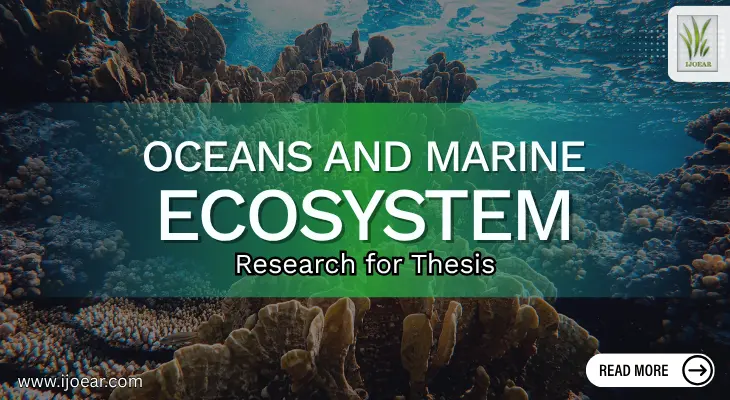
Oceans cover over 70% of the Earth’s surface and play a major role in regulating climate, supporting biodiversity, and providing food and livelihoods for millions. For students and researchers working on a thesis in environmental science, biology, or marine studies, oceans and marine ecosystems offer a vast and exciting field of research.
This blog explores key areas and ideas you can consider when writing your thesis on marine ecosystems.
Marine ecosystems are among the most diverse and productive systems on the planet. They include coral reefs, estuaries, mangroves, deep-sea trenches, and open oceans. Studying these environments helps us:
Here are some trending and impactful research areas you can include in your thesis:
Coral reefs, often called the “rainforests of the sea,” are among the most diverse ecosystems on Earth. However, they are under serious threat.
Plastic waste is a growing concern for marine environments, especially the presence of microplastics.
The rising concentration of atmospheric CO₂ is not only warming the oceans but also changing their chemistry.
Conserving marine life is central to maintaining ocean health and resilience.
Overfishing has severely impacted global fish stocks.
Coastal ecosystems like mangroves, seagrasses, and salt marshes are essential for climate regulation.
The deep sea remains one of the least explored regions of our planet.
Marine ecosystems support human life in countless ways.
Depending on your thesis scope, your methodology may include:
Writing a thesis on oceans and marine ecosystems isn’t just about academic achievement—it’s a chance to contribute meaningfully to global sustainability. With rising concerns about climate change and ocean health, your research can help shape policies, protect marine life, and inspire solutions for the future.
So, contribute your research expertise in the ocean of knowledge.
Q1. Why is research on oceans and marine ecosystems important for a thesis?
Ans: Oceans cover over 70% of the Earth’s surface and play a crucial role in climate regulation, biodiversity, and the global economy. Studying marine ecosystems provides valuable insights into climate change, food security, conservation, and sustainable development—making it a rich and relevant area for academic research.
Q2. What are the emerging research areas in marine studies?
Ans: Some of the latest research areas include coral reef restoration, microplastics impact, marine biodiversity, ocean acidification, deep-sea ecosystems, blue carbon solutions, and sustainable fisheries management.
Q3. How can I collect data for ocean research if I don’t live near the coast?
Ans: Many researchers use secondary data from government agencies, satellite imagery, oceanographic databases (like NOAA or UNEP), or partner with coastal institutions. You can also conduct literature reviews and data analysis using existing datasets.
Q4. What are “blue carbon ecosystems” and why are they important?
Ans: Blue carbon ecosystems—such as mangroves, seagrasses, and salt marshes—store large amounts of carbon and help reduce greenhouse gases. They also support biodiversity, protect coastlines, and are critical in climate change mitigation strategies.
Q5. What tools or technologies are used in marine ecosystem research?
Ans: Common tools include GIS mapping, satellite tracking, ROVs (remotely operated vehicles), sonar systems, genetic sequencing, water quality testing kits, and oceanographic modeling software.
Q6. How does ocean acidification affect marine life?
Ans: Ocean acidification, caused by increased CO₂ absorption, reduces the availability of calcium carbonate—essential for shell-building organisms like corals, mollusks, and some plankton. This disrupts food chains and weakens ecosystem resilience.
Q7. What are some real-world applications of marine research?
Ans: Research findings support marine conservation policies, fishery regulations, climate action plans, tourism sustainability, coastal urban planning, and pharmaceutical development from marine resources.
 NAAS Rating: 4.23
NAAS Rating: 4.23  October 2025 Issue
October 2025 Issue  Impact Factor: 6.69
Impact Factor: 6.69  Submit Article
Submit Article 
|
Citation Indices
|
All
|
Since 2020
|
|
Citation
|
6164
|
5117
|
|
h-index
|
31
|
29
|
|
i10-index
|
201
|
165
|
|
Acceptance Rate (By Year)
|
|
|
Year
|
Percentage
|
|
2024
|
11.09%
|
|
2023
|
15.23%
|
|
2022
|
12.81%
|
|
2021
|
10.45%
|
|
2020
|
9.6%
|
|
2019
|
14.3%
|
|
2018
|
17.65%
|
|
2017
|
16.9%
|
|
2016
|
22.9%
|
|
2015
|
26.1%
|